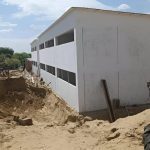The National Commission for Space Activities (Conae) celebrates this Saturday 31 years of its foundation with advances in the development of the family of Tronador II and III launchers, rockets about 28 meters high and weighing 90 tons with which it seeks to put satellites weighing 750 kilos into orbits of up to 700 kilometers in height from a space port near the Buenos Aires town of Bahía Blanca.
The development of the space vehicle was awarded by Conae to the state company VENG (New Generation Space Vehicle), which is in charge of manufacturing and integration of components in the Punta Indio Space Center (CEPI).
Cold welding machines, unique in South America and necessary for the construction of the fuel tanks and rocket fuselage, which require materials whose integrity is not affected by the production process, were installed there.
The CEPI is located on the site of an old cement plant in the town of Pipinasabout 140 kilometers southeast of the City of Buenos Aires, and has a spaceport in La Capetina, on the coast of the Río de La Plata, from where three experimental launches were made between 2014 and 2017.
The executive and technical director of Conae, Raúl Kulichevsky, and the president of VENG Y dean of the Faculty of Engineering of the National University of La Plata (UNLP), Marcos Actis, received Télam in the CEPI hangar, where the friction stir welding machine is located, which manufactures the primary structures of the tanks and fuselages that will form part of the next Tronador II launch vehicles .
“The development of the Tronador product is the great challenge that Conae has today; in the satellite part we are capable of developing different types of missions with different characteristics and instruments and we have achievements such as the Saocoms with the launching of L-band radars into orbit, which is the most complex in terms of technology with satellites,” Kulichevsky said in dialogue with Tel.
such a challenge “it involves acquiring technologies in which we still have a lot to developr, and at the same time a lot to build in infrastructure,” considered the director of Conae, who highlighted the adaptation works that lie ahead for the manufacture and integration of vehicles and the training of personnel.
The objective of Tronador II/III is that it becomes a launcher for earth observation satellites weighing up to 750 kilos in orbits between 600 and 700 kilometers high, a first step in thinking about how to continue evolving into more powerful launchers.
“The development of access to space has been present since the creation of Conae and before too; for many years the priorities They were concentrated on the simultaneous development of very important projects such as SAC-D or the saocom qthat demanded a budgetary effort, and that, in the face of budget ups and downs, meant that projects like the Tronador were at times more relegated,” Kulichevsky recalled.
In this regard, he stressed that “Today we are in different conditions and returning to Tronador“. Although he maintained that suspending a development has disadvantages because “there are people who are no longer here, infrastructures that may have been degraded or technological solutions that have already been overcome.”
In this regard, Actis told Télam that there are companies closely linked to these developments that are not working “because they had a very bad time in recent years.”
“Of the 160 people we had working on this at the UNLP, practically half left, that is now recovering and if it weren’t for the pandemic, this project would have been reactivated earlier,” he explained.
The engineer stressed that many workers of Argentine companies that generate aerospace or satellite products were trained by Conae through projects such as the Tronador.
Regarding the next steps, Kulichevsky maintained that “the logic of test launches is acquire technological maturity in different systemssuch as propulsion, avionics, structures, and everything related to the ground segment that is as important as the rocket or the satellite”.

“It’s a multi-year work plan because they are complex developments that require several intermediate steps,” he explained.
For its part, Actis pondered that “a lot was learned from the launch campaign, all vehicle navigation was amply demonstrated by test launches, remote management, and now it is aimed at consolidating the engine, especially the turbopump that It is the heart of the engine and whose development had been discontinued at the end of 2015”.
“The engine is something that has already been proven and is now working on the manufacturing processes to make it lighter, but what makes it difficult is that until the end of 2015 there were national companies capable of melting and working with this type of material that today is no longer available. “, he added.
Kulichevsky detailed “We’re going to need 4 or 5 successful launches to know we’ve mastered the technology before moving on to the next stage.”
“Tronador II will have different versions depending on the diameter of the launcher, 70, 150 and 250 centimeters, which is the one that will be operational together with Tronador III; there are at least six or seven years of work ahead,” he said.
He also explained that private companies are emerging in the space sector, many of which can make small launchers, but not face a project of the size of the Tronador.
“Putting a 50-kilogram satellite into orbit is not the same as putting a 750-kilogram satellite into orbit, and that capacity continues to be in a very competitive market with few providers, but with many opportunities. There is prospecting for the coming years of thousands of satellites seeking service of launch and being able to offer that possibility opens up a universe of new opportunities”, Kulichevsky added.

Conae develops Earth observation satellite missions in Argentina, with the aim of generating spatial information on the continental and maritime territory for the benefit of the country and Latin America.
The National Space Plan contemplates the development of the launch capacity of the satellites of the SARE project to place them in orbit from Argentine territory with the Tronador II/III launcher, and the provision of capabilities for telemetry and telecommand (TT&C) activities, acquisition and processing of satellite information received through the Network of Earth Stations strategically distributed.


















